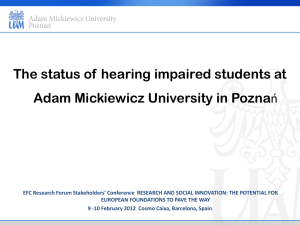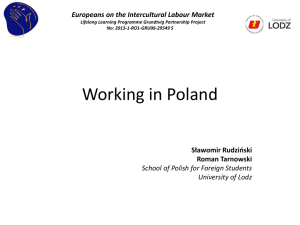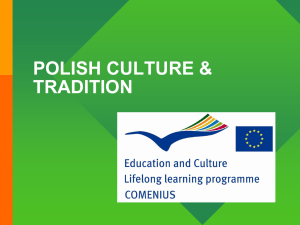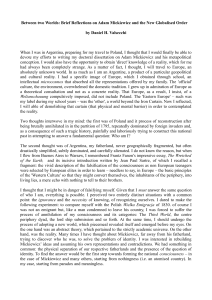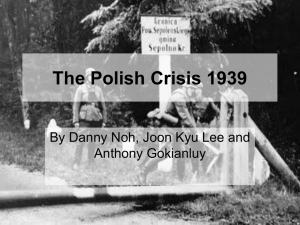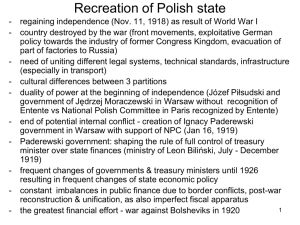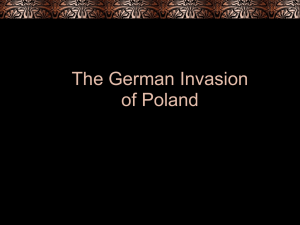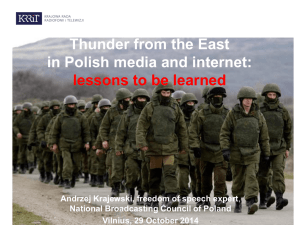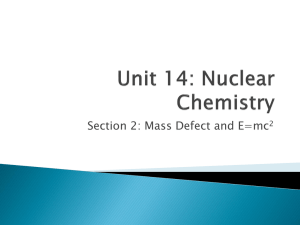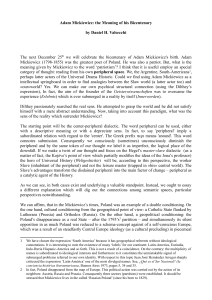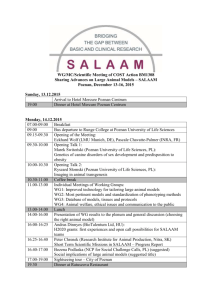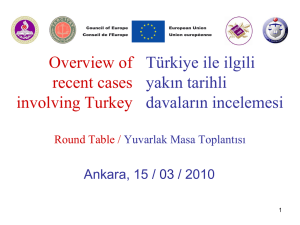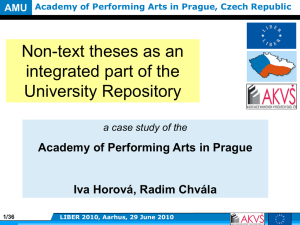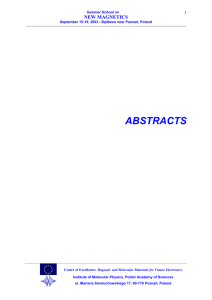Adam Mickiewicz University a long tradition of Academic Pozna*
advertisement
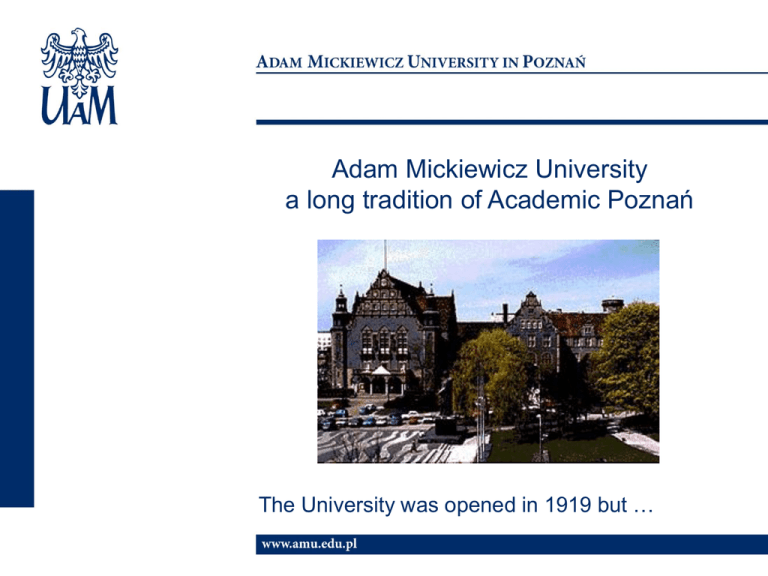
Adam Mickiewicz University a long tradition of Academic Poznań The University was opened in 1919 but … Where we are? Polish-Lithuanian Commonwealth in 1619 Ottoman Empire Poland in the UE now Polonya (Lehçe: Polska (yardım·bilgi), okunuşu: /pɔls.ka/), resmî adı Polonya Cumhuriyeti (Lehçe: Rzeczpospolita Polska (yardım·bilgi), okunuşu: /ʐɛt͡ʂ.pɔsˈ.pɔ.lʲita pɔls.ka/) Orta Avrupa'da bulunan bir ülke. Komşuları, batıda Almanya, güneybatıda Çek Cumhuriyeti, güneyde Slovakya, kuzeydoğuda Rusya Federasyonu ve Litvanya, doğuda Belarus, güneydoğuda Ukrayna ve kuzeyde Baltık Denizi'dir. Ülke 312.679 km²'lik yüzölçümüyle Avrupa'nın dokuzuncu, dünyanın altmış dokuzuncu büyük ülkesidir. Yaklaşık 38 milyonluk nüfusuyla dünya sıralamasında en kalabalık 33. ülkedir. A flash from history… • • • • • • Xth century – christianization of Poland since 966 by the Duke Mieszko I (in Poznań) Since 1025 – Kingdom of Poland Since 1385 until 1572 – Jagiellon dynasty - Poland is a regional power (in rivalry witht Turkey for the south-east Europe) 1414 – first diplomatic agreement between Poland and Turkey (Władysław Jagiełło-Mehmed I) (first diplomatic contacts between the Ottoman Empire and Christian Europe XVI-XVII century – in multiple wars against Russia, Sweeden, Turkey, Cossack uprisings, Battle of Vienna aginst Ottoman army (Kara Mustafa) 1683 • • • • 1500 Jagiellonian Kingdoms • • Ottoman Empire • • XVII wars and decline of the Kingdom partitions of Poland in 1772, 1793, 1795 Polish patriots particpate in the Napoleon Bonaparte wars political and moral support from the Ottoman Empire for Polish independence (Turkey never recognized the partition of Poland) Russo-Turkish war (1768-1774) for Polish independence Polish legions participated in the Crimean War (1853-1856) as a part of Turkish Army very good relations between Poland and Turkey after the First World War. Very good bilateral contacts. Poland joined the EU on May 1, 2004. Collaboration for war and peace At the Crimean War polish partiots attemted to form a Polish Legion (initiative of Adam Mickiewicz) Michał Czajkowski, Sadyk Pasza, Mehmed Sadyk Effendi (Polonezköy), Crimean War (1853-1856) Mickiewicz's temporary grave under his Istanbul apartment, now Adam Mickiewicz Museum Władysław Miśkiewicz (1820?-1883) in the Czajkowski’s Legion A Polish noblemen in typical oriental costume of Turkish origine (kontos) (XVII c.) Collaboration between the Adam Mickiewicz University and Turkish Government Research mission by prof. Tadeusz Vetulani in Anatolya Womans in common history Haseki Hürrem Sultan, Roxelana (born Aleksandra Lisowska (1506-1558)) Wife of Suleiman the Magnificent Ayşe Leyla Gencer, (d. 10 Ekim 1928; Polonezköy, ö. 10 Mayıs 2008[1]; Milano), Türk opera sanatçısı. 20. yüzyılın en önemli sopranolarından birisi olarak görülür Leyla Gencer 1928'de Polonezköy'de doğdu. Babası Safranbolulu köklü Müslüman bir ailenin oğlu olan Hasanzade İbrahim Bey, annesi Polonyalı Katolik bir ailenin kızı olan Alexandra Angela Minakovska'dır. Ailesi sonradan Çeyrekgil soyadını aldı. Annesi, İbrahim beyle evlendikten sonra Müslüman olup Atiye adını aldı. Gencer ileriki yıllarda bir röportajında "Müslüman ve oryantal bir altyapıdan geliyorum" demiştir.[1] Womans in common history Haseki Hürrem Sultan, Roxelana (born Aleksandra Lisowska (1506-1558)) Wife of Suleiman the Magnificent Ayşe Leyla Gencer (ur. 10 października 1928 w Polonezköy, zm. 10 maja 2008 w Mediolanie[1][2]) – turecka śpiewaczka operowa, sopran, jedna z najsłynniejszych wykonawczyń ról bel canto. Nazywana "Królową" oraz "Divą turecką". Jej matka Alexandra Angela Minakovska była Polką, pochodzącą z Polonezköy – polskiej wioski w Turcji. Ukończyła konserwatorium w Stambule, po czym uczyła się prywatnie w Ankarze razem z włoską sopranistką Gianniną Arangi-Lombardi i śpiewała w chórze tureckiego teatru narodowego. W 1950 r. zadebiutowała jako Santuzza w Rycerskości wieśniaczej. Jej talent został szybko dostrzeżony w kraju, jednak artystka już po trzech latach wyjechała na zawsze z Turcji, by robić karierę na scenach włoskich. Miała tam spędzić resztę swojego życia. ADAM MICKIEWICZ UNIVERSITY Founded in 1919 it inherits from the tradition of Lubrański Academy founded in 1519 and the tradition of Jesuit College founded in 1573. The College of Jesuits was transformed into the University by a law of privilege of October 28, 1611 from the King Sigismund III Vasa (but this law was never applied). After the Second World War (in the 50ties) the university gave birth to a number of academic schools like the University of Medicine, University of Agriculture, Academy of Sports. Now, UAM constitutes the community of students, teachers and administrative staff which amounts to more then 50,000 people. It is divided into 15 faculties: Biology, Chemistry, English, Educational studies, Geography and Geology, History, Law and Administration, Mathematics and Computer Science, Modern Languages and Literature, Pedagogy and Fine Arts, Physics, Polish and Classical Philologies, Political Sciences and Journalism Social Sciences, Theology. The AMU Centre for Sport and Exercise has inter-faculty character Faculty of Mathematics and Computer Science Faculty of Mathematics and Artificial Intelligence PL-61614 Poznań ul. Umultowska 87 tel. +48-61-8295308, fax +48-61-8295315 The main research domains at the Faculty of mathematics and computer science are the following • in mathematics: functional analysis, number theory, graph theory, mathematical logic, theory of formal languages, numerical analysis. • in computer science: language engineering and computer linguistics (computer undestanding of natural language, electronic language resources), AI, theoretical computer science. Teaching is based on lectures, practical laboratory work, projects and individual consultations. Research is organised in seminars and projects which often have inter-faculty character and involve students. Department of Computer Linguistics and Artificial Intelligence – recent and current research areas Department of Computer Linguistics and Artificial Intelligence PL-61614 Poznań, ul. Umultowska 87 tel. +48-61-8295380, fax +48-61-8295315 Head of Department: Prof. dr hab. Zygmunt Vetulani http://main/amu.edu. pl/~zlisi vetulani@amu.edu.pl Prof. Zygmunt Vetulani Natural Language Understanding (text) Dialogue Systems, Man-Machine Communication WordNet („PolNet-Polish Wordnet”) Morphologic Dictionaries, parsing of free word order languages Publications: www.amu.edu.pl/~vetulani Dr Jacek Marciniak LT and AI in application to e-learning; inteligent tutoring systems; ontologies Dr Tomasz Obrębski Development of rule based dependency parsing Text processing technologies in the research on speech disorder in schizophrenia. Dr Marek Kubis Tools for wordnet processing and maintenance Department of Computer Linguistics and Artificial Intelligence – recent and current research areas Department of Computer Linguistics and Artificial Intelligence PL-61614 Poznań, ul. Umultowska 87 tel. +48-61-8295380, fax +48-61-8295315 Head of Department: Prof. dr hab. Zygmunt Vetulani http://main/amu.edu. pl/~zlisi vetulani@amu.edu.pl Every two years the Department organises the Language and Technology Conferences: Human Language Technologies as a Challenge for Computer Science and Linguistics. Former conferences were organised in 1995, 2005, 2007, 2009, 2011, 2013 in Poznań. 3 days, over 100 papers presented each time; participants from over 40 countries (in increase). Information: http://www.ltc.amu.edu.pl Department of Computer Linguistics and Artificial Intelligence Current research team members and LTC 2013 organisers Department of Computer Linguistics and Artificial Intelligence PL-61614 Poznań, ul. Umultowska 87 tel. +48-61-8295380, fax +48-61-8295315 Head of Department: Prof. dr hab. Zygmunt Vetulani http://main/amu.edu. pl/~zlisi vetulani@amu.edu.pl

